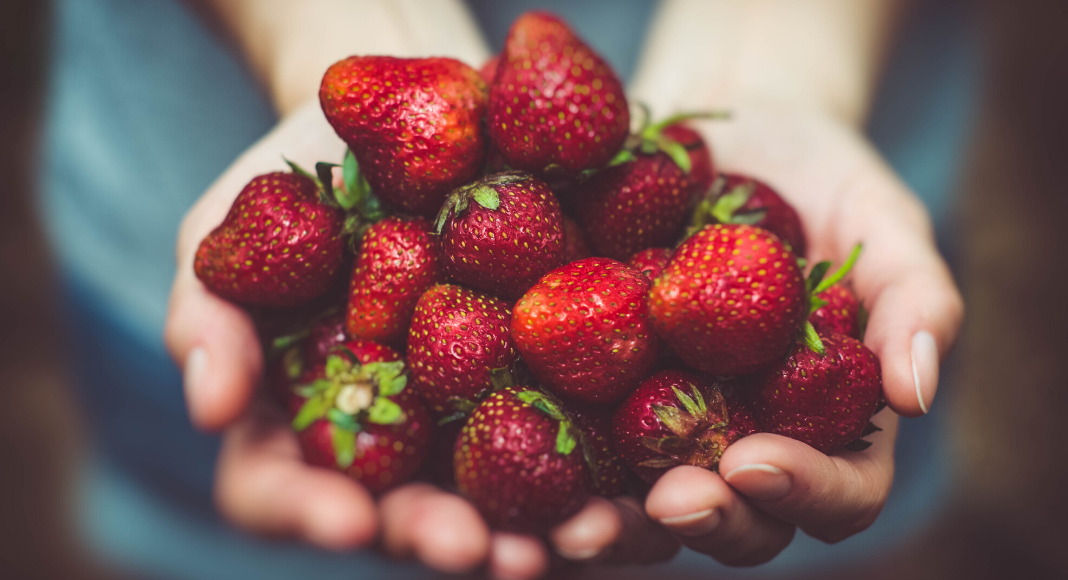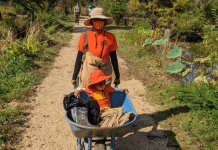The Washington, DC area is peppered with many historical sites, monuments, and museums. Everywhere you look, history happened here. When my family drove by Woodlawn Manor Cultural Park on our way to a socially distanced birthday party parade on the 4th of July, we knew we’d have to come back. Located 12 miles north of DC in Sandy Spring, MD (just about a straight shot up Georgia Ave NW), the historic park contains the Underground Railroad Experience Trail. Not having done a hike on a trail that was once part of the Underground Railroad and knowing that it’s important to visit historic sites that focus on Black history and the civil rights movement, my husband and I decided to spend a day on the trail the very next weekend.
The day we picked was hot. It seemed like the hottest day of the summer. The temperature was in the high 90s, and it seemed to be climbing. When we arrived at Woodlawn Manor Cultural Park in the early afternoon, the parking lot was practically empty. We had read that the parking lot fills up quickly, but that’s not the case right now—or at least it wasn’t that particular Saturday. The park wasn’t offering guided tours because of COVID-19, and we practically had the park to ourselves. Luckily, the park offers self-guided brochures for the trail, so we picked one up and we were on our way. (Guided hikes are now available, with safety measures in place. Reserve a spot in advance.)

A Quiet Quaker Community
The trail starts near Woodlawn Manor, which was owned by a Quaker named William Palmer. While the Quaker community was anti-slavery, the Palmer family had slaves working beside free black laborers at Woodlawn. In normal times (aka when there’s not a global pandemic happening), the manor is open for tours. Since we knew everything was closed, we walked past the manor and briefly stopped at the barn where you can normally learn about the people who lived there and the history that happened there.
Beside the barn, there was a horse field, but no horses were out running about. Maybe it was too hot, or maybe social distancing isn’t for horses. Either way, the start of the trail set the tone for the hike. While we were standing in a wide, open space, I doubted freedom seekers traveling along the Underground Railroad had that same privlege.
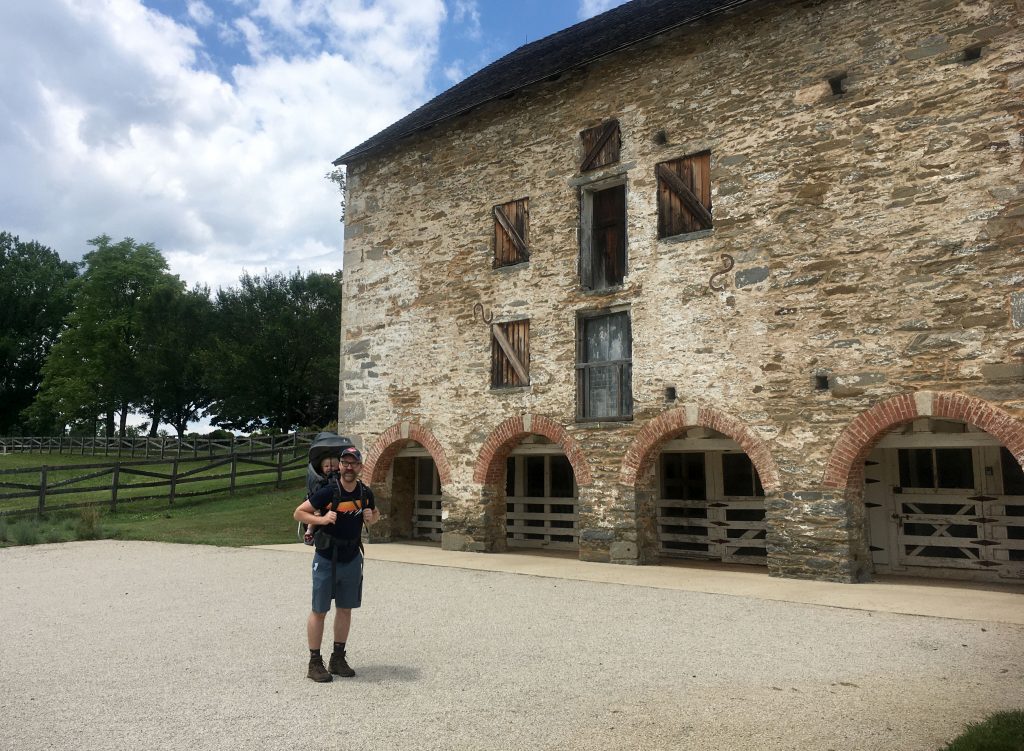
Discovering Detours
Even in the beginning, the trail had some diversions. My husband had read that there are many different offshoots from the main trail, so it’s easy to get lost. We followed a path into a forest of bamboo to a murky pond that connects to the Anacostia River. I thought about the freedom seekers traveling this trail just about 200 years ago. Were they able to get fresh water? We certainly needed water that day. We later ran out at the end before turning back around, wishing we had packed more.
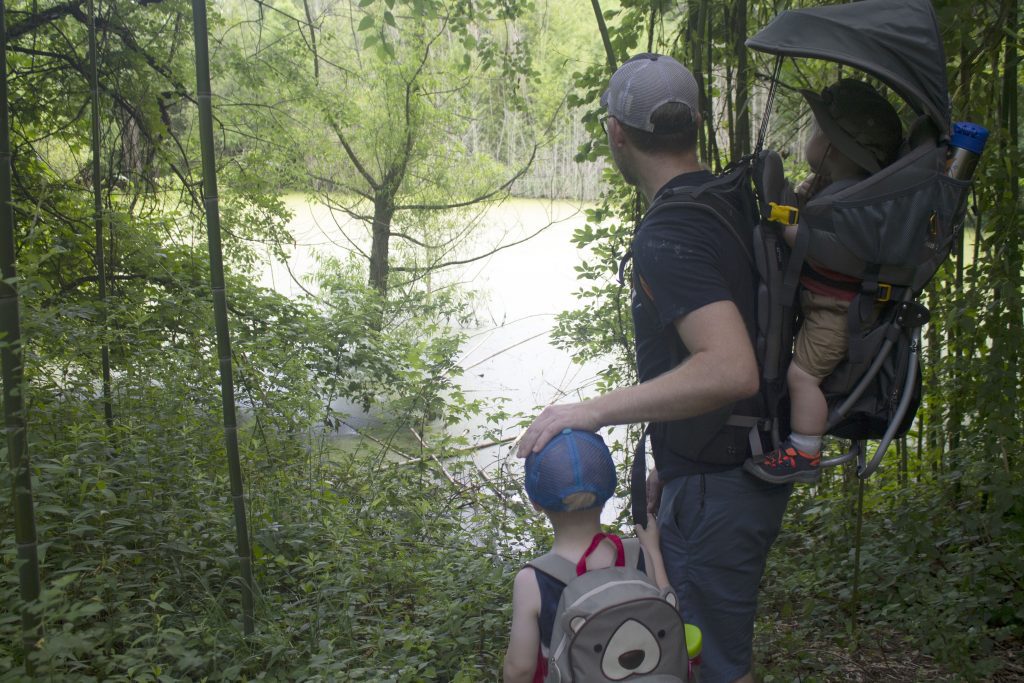
After our brief detour to the pond, we got back on track walking through an open field. We wondered when we’d find shade and get out of the sun on the Underground Railroad Experience Trail. It really was a beautiful day to be outside enjoying both nature and history along the way.
 During this part of the hike, I noticed wild blackberries and raspberries growing all around. I wondered if the people who came through here ate berries as they traveled. But that thought quickly vanished as my husband read from the brochure that freedom seekers usually traveled around Christmastime. Since they got a few days off around the holiday, it was easier to leave without being noticed. There would not have been berries growing here in December. What did they eat? How did they survive?
During this part of the hike, I noticed wild blackberries and raspberries growing all around. I wondered if the people who came through here ate berries as they traveled. But that thought quickly vanished as my husband read from the brochure that freedom seekers usually traveled around Christmastime. Since they got a few days off around the holiday, it was easier to leave without being noticed. There would not have been berries growing here in December. What did they eat? How did they survive?

A Shade of Relief
The trail finally ducked into a shaded wooded area. The temperature dropped, but we were already soaked in sweat from walking in the field. The trail was now dense with trees, vines, and shrubs everywhere.
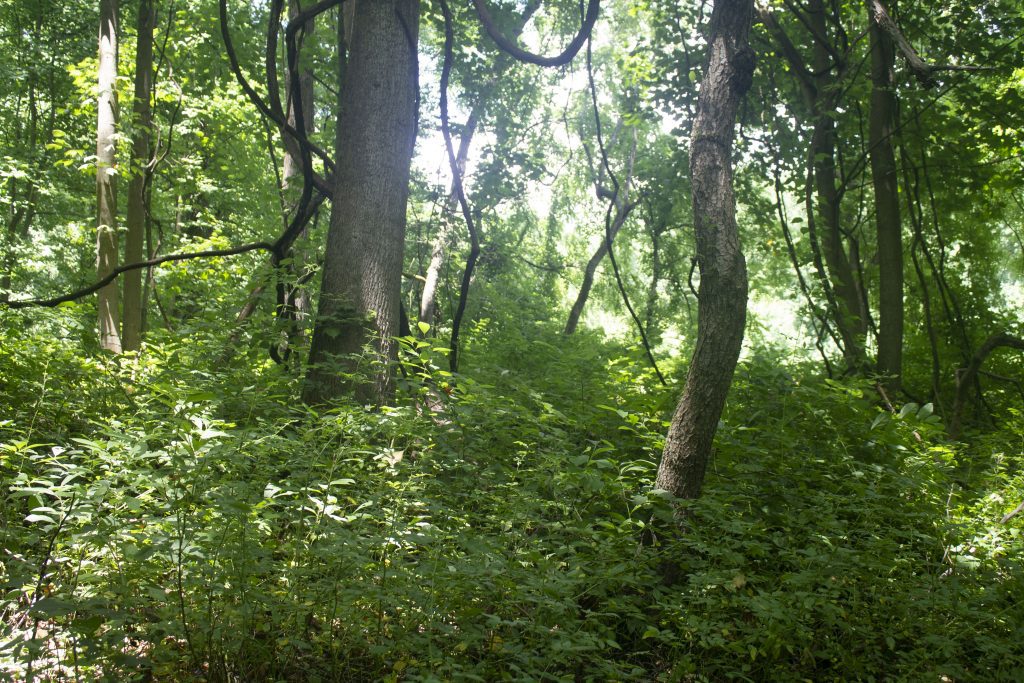 If someone was traveling through this area in December, it would look much different—much more bare. My husband read from the brochure that freedom seekers often hid and slept under bramble bushes, as horses and slave catchers would avoid stepping nearby.
If someone was traveling through this area in December, it would look much different—much more bare. My husband read from the brochure that freedom seekers often hid and slept under bramble bushes, as horses and slave catchers would avoid stepping nearby.
We took one offshoot to check out a hollow tree. Freedom seekers often used hollow trees to help them find their way or as a place to sleep and hide from slave catchers. I made the mistake of telling my son that it was full of spider webs—which it was—and he didn’t dare go in to check it out.
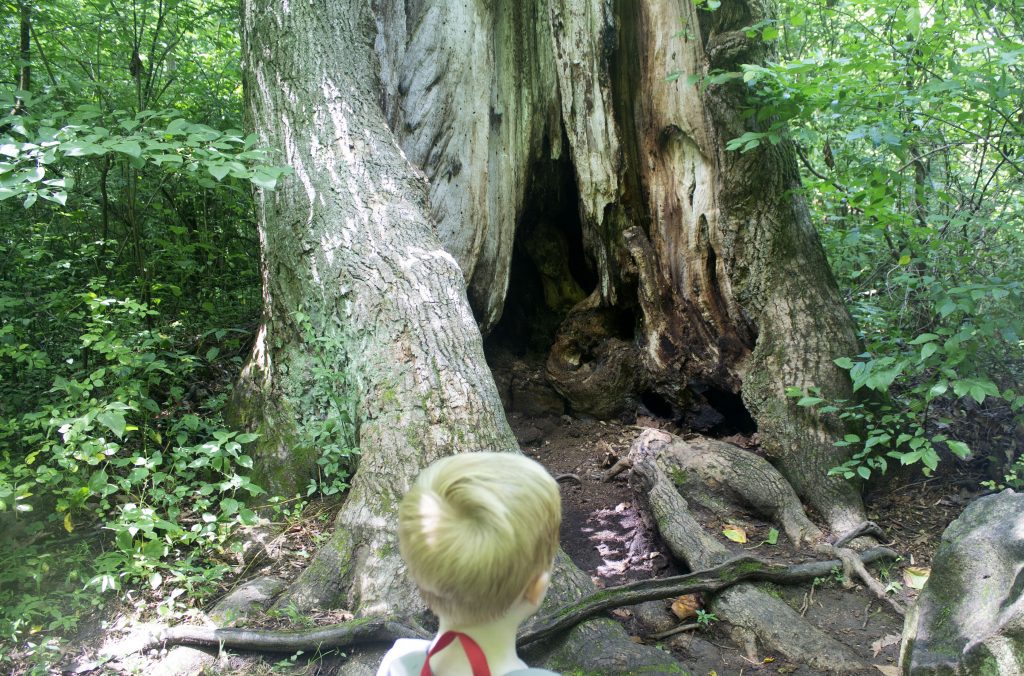 We stopped for lunch at a lone bench near a small wooden bridge. It turned out to be one of three areas I felt was suitable to stop for a break. But since it was well after lunchtime, we decided to pause for a moment here and feed the kids. We weren’t aware that we could have eaten lunch at the shaded spot beside the origin of Sandy Spring or at the very end at the grassy park by the big tree.
We stopped for lunch at a lone bench near a small wooden bridge. It turned out to be one of three areas I felt was suitable to stop for a break. But since it was well after lunchtime, we decided to pause for a moment here and feed the kids. We weren’t aware that we could have eaten lunch at the shaded spot beside the origin of Sandy Spring or at the very end at the grassy park by the big tree.
Wildlife Sightings
For the most part, the trail was well worn, with little change in elevation and difficulty. My toddler was in good spirits at this point, still walking on his own and helping to spot wildlife along the way. So far, we had spotted a ladybug and a couple of dragonflies. We eventually saw more signs of wildlife, including a shed snakeskin, the remains of what we believe were Eastern Hercules Beetles, and a praying mantis.
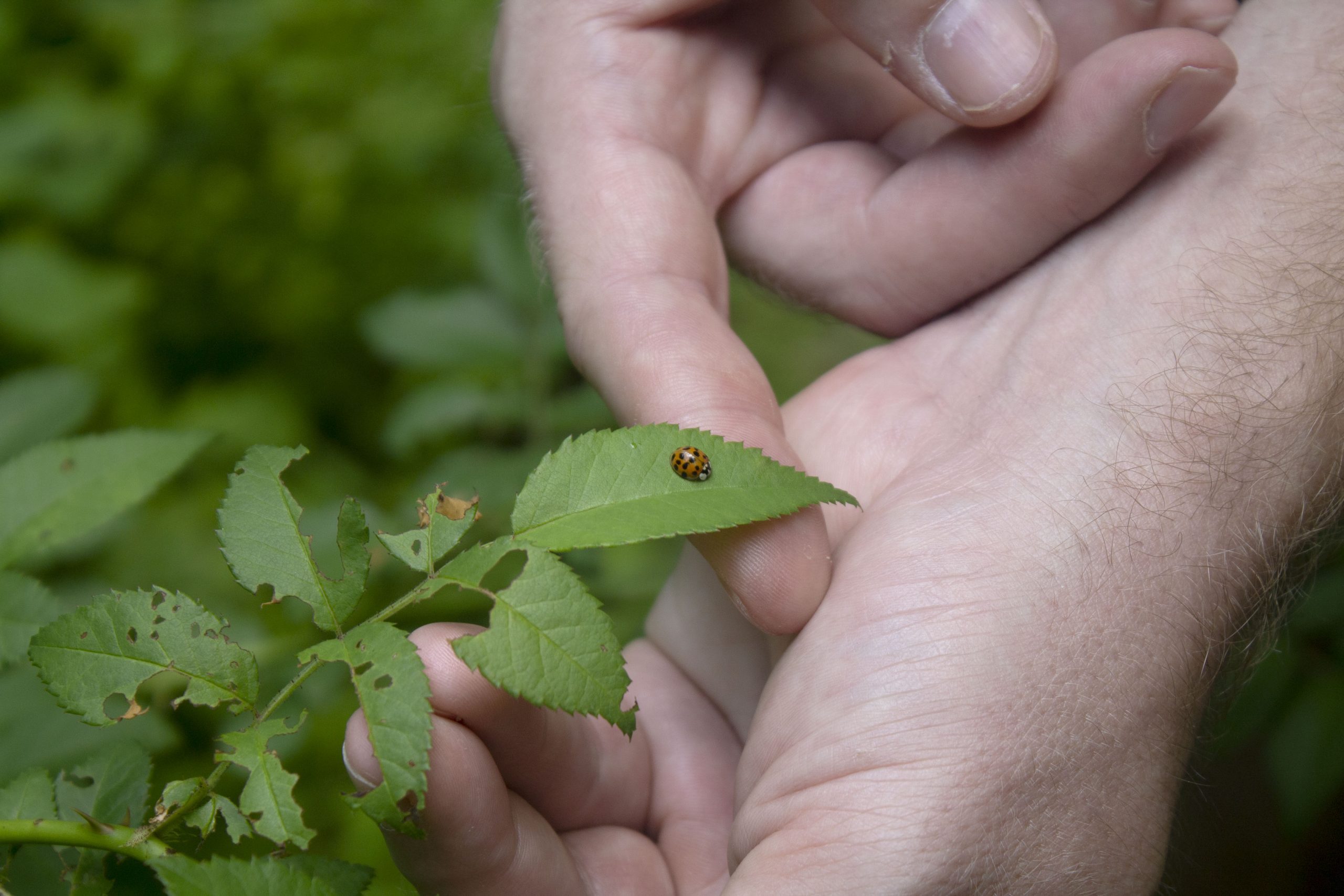
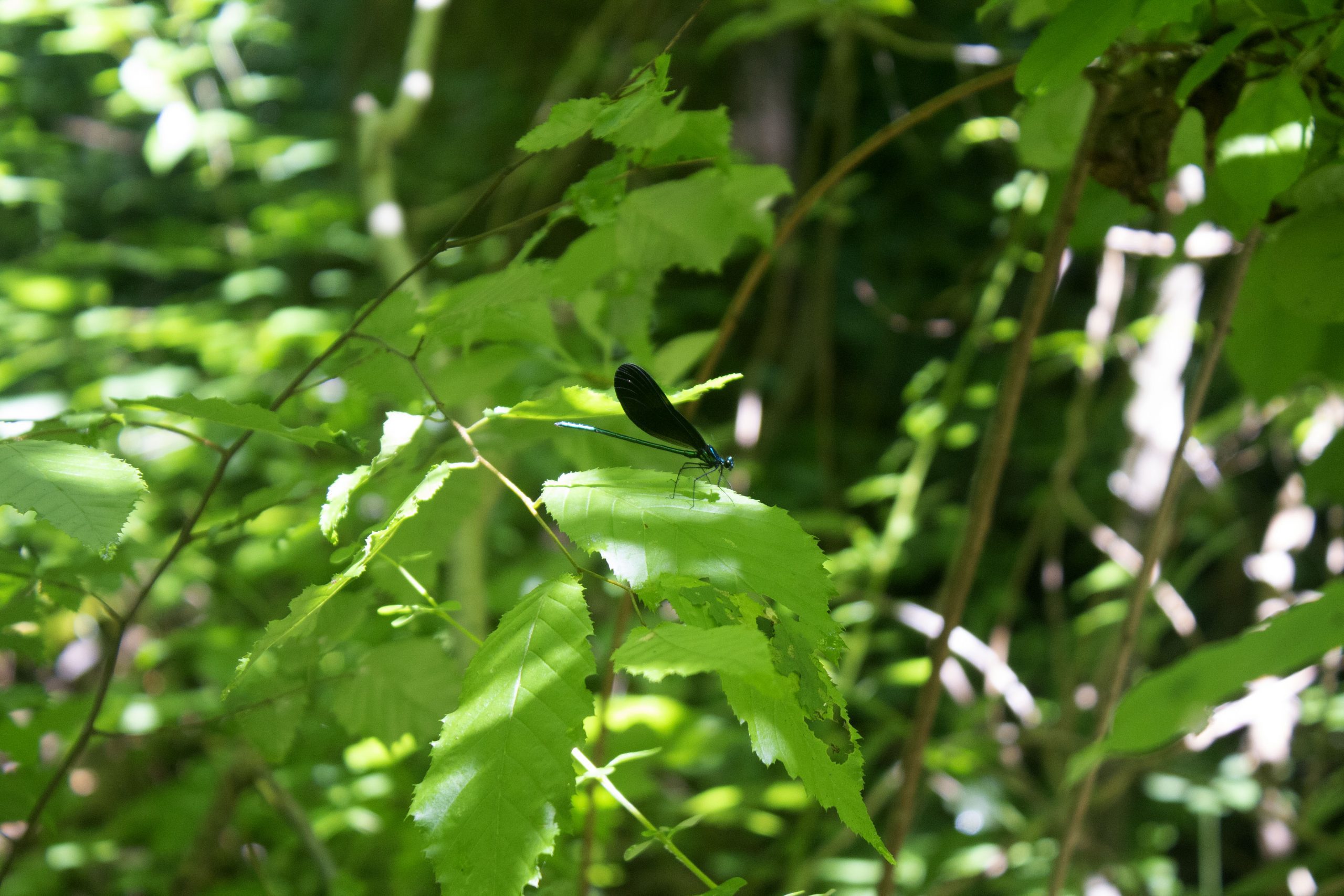
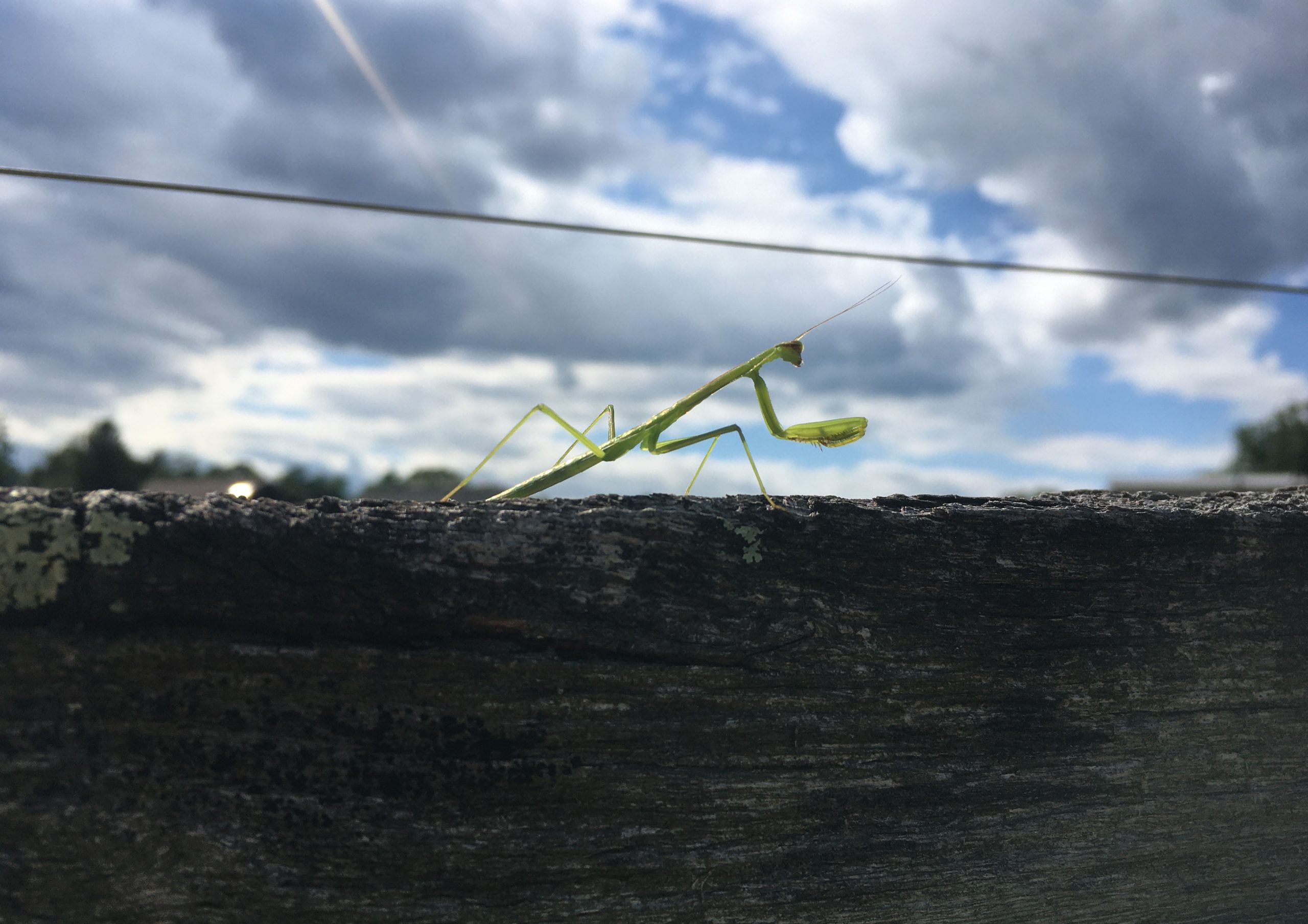
At one point, the trail looped around an open field beside a wooded area flanking the Anacostia River. The grasses were tall, and the sun was hot. The trail reminded me of an old dirt road. It eventually brought us to a shady area featuring the origin of Sandy Spring. It was cool and shaded—a great place for a water break.
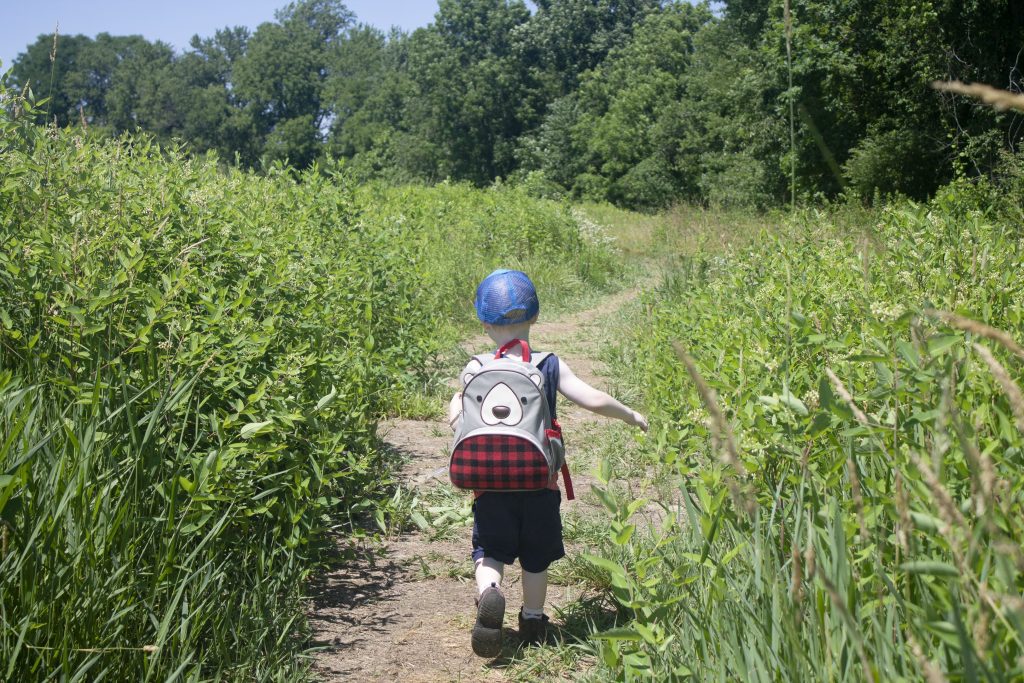 We continued on down the dirt road, which was shaded only by a row of tall trees on either side. Wide-open fields flanked both rows of trees, and we knew we were getting close to the big old tree that freedom seekers knew signaled safety.
We continued on down the dirt road, which was shaded only by a row of tall trees on either side. Wide-open fields flanked both rows of trees, and we knew we were getting close to the big old tree that freedom seekers knew signaled safety.
Sighting Safety
The end of the trail opens up into a grassy park that’s now beside the cal-du-sac of a retirement community. The old tree is short and stout, but very wide and grand. Beside the tree are a few carefully placed boulders, one of which has a plaque explaining the tree’s significance on the Underground Railroad. The boys played by the rocks for a bit, while my husband and I calculated our next steps. The trail was 2 miles in, 2 miles out. We didn’t think our 3-year-old could make the walk back without being carried.
Luckily, we had brought along a second baby carrier for this reason, and we strapped both kids into their own carriers. It’s a good thing too—our 3-year-old fell asleep almost instantly. We hiked back together until we came to a fork in the trail. Usually, my husband and I stay together when we hike—I’m just not comfortable being alone on the trail—but this time, I was open to the idea of seeing which way was faster. He took the path leading into the woods full of shade. I stayed the course walking through an open field in the blistering sun.
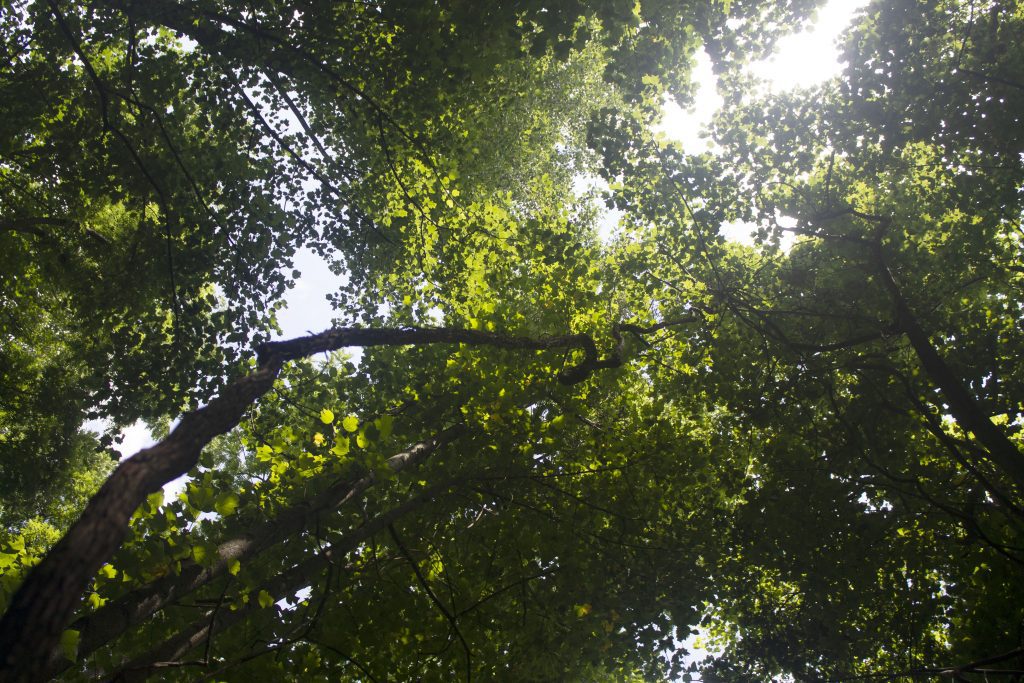 A Place for Reflection
A Place for Reflection
It was the first time in a long time when I was “alone.” (I was carrying my 1-year-old, so I wasn’t completely alone.) I hadn’t really ever been completely alone during all of the quarantine. I was a little nervous at first, given all the unknowns of walking a trail alone. But then I got lost in my thoughts about this trail, a trail freedom seekers traveled on. Had any of them been alone? What were they thinking about while they made this journey?
My mind wandered. I’ve been thinking a lot about how I will talk to my children about race and racism, and the Underground Railroad will be a part of that. I thought about action steps I’ve read about to take to become anti-racist. I thought about the materials I needed to dig into to help me nurture my children with empathy and understanding for the challenges Black Americans face every day. The Underground Railroad Experience Trail is just one piece of the National Park Service National Underground Railroad Network to Freedom program which honors the sacrifice and bravery of thousands of freedom seekers traveled north to escape from slavery. Yet many of us still have a journey to make in order to move forward and help take steps towards fixing all that slavery broke.
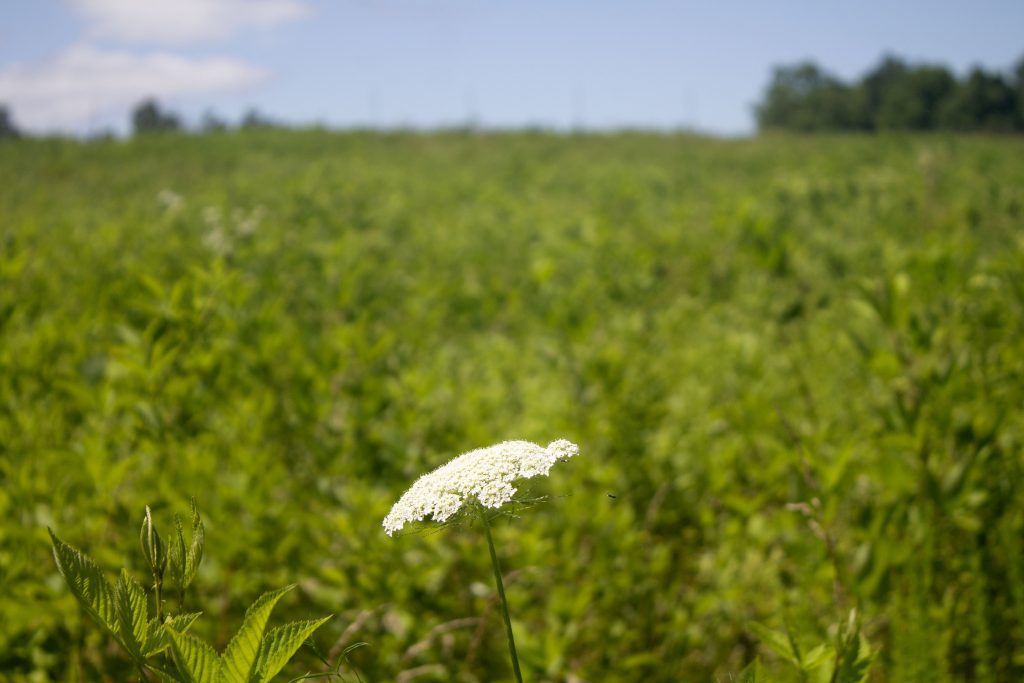 The Joy of an Out and Back Trail
The Joy of an Out and Back Trail
My husband and I met up eventually, although my path was faster than his. While completely cool with shade, my husband’s trail proved more difficult with a rocky incline and a small, curvy path. My husband knows I hate hiking uphill and commented that I had chosen the best path for me. We walked the rest of the trail together at a modest pace. Despite carrying one kid each, and picking up my 1-year-old’s sippy cup every couple of steps, we were able to hike the 2 miles back in 45 minutes.
We spent a total of about 3 hours on the trail, taking it slow and steady with our 3-year-old walking on his own during the first half. 2 miles is pretty impressive for a 3-year-old, especially given the heat and his backpack. (He insisted on carrying his backpack full of Hot Wheels Monster Trucks, despite playing with them only once on the trail.) Maybe someday he’ll learn to pack light on hikes.
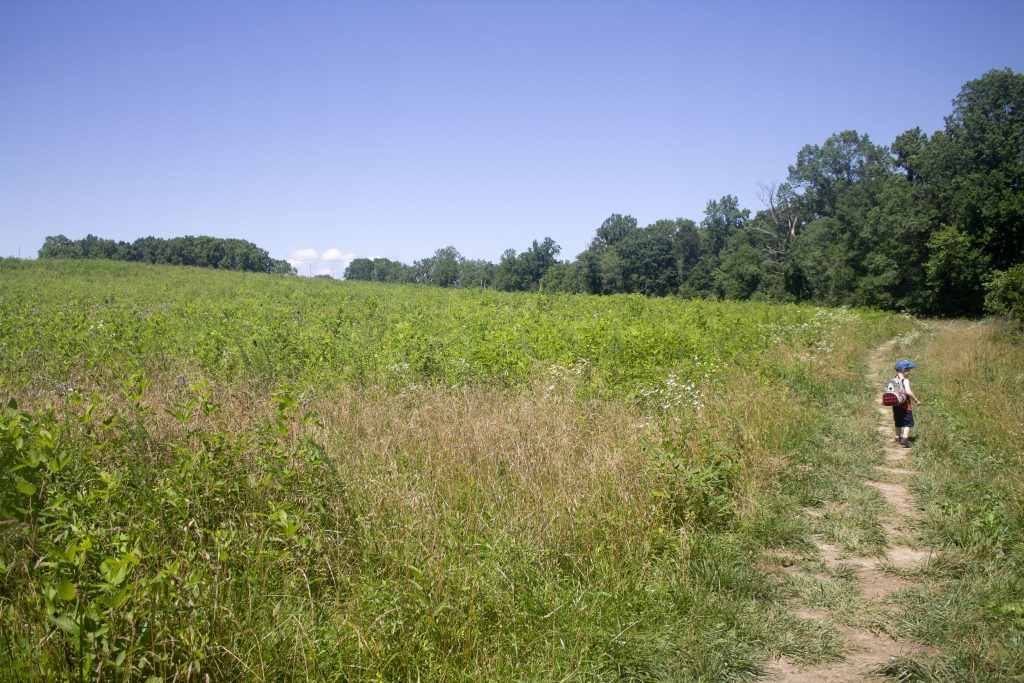 A Fun Day Hike for the Whole Family
A Fun Day Hike for the Whole Family
If you decide to hike this trail with your family, I recommend bringing plenty of water. We packed just 3 water bottles for our family of 4, and it was not enough. We wish we had packed 1 water bottle each, plus an extra one. Sunscreen is a must if you hike on an especially sunny day. The trail contains quite a few stretches that are not shaded. We also wish we had remembered to bring bug spray. It seems like it’s harder to remember to pack everything now that we have two kids.
Overall, we had an enjoyable afternoon at the Underground Railroad Experience Trail. The kids had a wonderful time outside exploring, and my husband and I were able to distract ourselves from all the work that endlessly looms in our house as we continue to work from home and juggle childcare during the pandemic.
Check out this trail if you’re interested in history, and especially if you are seeking ways to connect with Black history. The trail contains quite a few informational signs which provide context about the story of the Underground Railroad and help you keep track of where you are and how far you have to go from various points. I was grateful for the chance to connect with nature and for the time to further reflect on how race and racism have impacted—and continue to impact—our nation.



